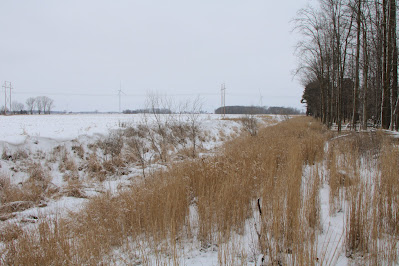The mid-day weather is windy, cloudy and cold (around 20 degrees) as I stand on the Blair Rd bridge looking east at the frozen, snow-covered, 10-ft wide county drain, a redirected channel of the Bad River. Leaving the road, I head east along a high bank where I’m pleased to see a wide buffer zone protecting the watercourse. Along the way, I spot the dead seed heads of Blue Vervain and think about its lovely blossoms in summer (stock photo). Nearby, I spot the snowcapped seedheads of Burdock and Teasel, swaying in the wind. Proceeding east, I pass a small cattail marsh displaying a large muskrat lodge. Muskrats that occupy these structures will likely remain in them throughout the winter. Just ahead in open cropland, I come upon a set of muskrat tracks leading to and from a hole where the rodent had been digging for something to eat. Looking around, I’m surprised to see it still digging, so I approach before it skedaddles toward the river. Muskrats don’t hibernate and remain somewhat active in winter. However, since they are most active at night and twilight, I’m surprised to see this one out and about. I suspect it came from an underground den dug into the nearby riverbank that includes an underwater entrance covered with ice. When I return to the riverbank and continue east, I hike adjacent to an 8-acre woodlot containing a mix of mature evergreen and broadleaf trees, while at my feet I spot Coyote tracks in the snow. Up ahead, I notice some dried seedpods of Moth Mullein and think about its lovely blossoms in summer (stock photo). Turning away from the river and entering the woodlot, I come upon another graveyard of large Ash trees strewn on the ground after being killed by the Emerald Ash Borer. Examining these downed logs more closely, I observe one covered with green and orange lichens and another with a single patch of Whitewash lichen. Looking up, I catch a glimpse of a cone and needles of Austrian Pine, a Red Pine look-a-like. Following some squirrel tracks, I notice a recently excavated cache of stored food. The question of how exactly these critters remember the locations of their caches is still a matter of debate, but it is thought they have spatial memory that use landmarks like trees, stumps and bushes as references. Once they get close, their sense of smell allows them to hone in. These mammals are also highly aware of their surroundings while caching and may pretend to bury a nut or seed in one spot if they think they’re being watched and then secretly bury it elsewhere. After exiting the woodlot, I turn west and head back toward the car while passing a deer carcass. Trudging through the snow into a stiff west wind, I finally arrive at the bridge, retreat to the car, turn on the heat and head for home.
In coldness of winter she lies down
A blanket of snow covers her ground
In newness of spring she comes alive
Warms the earth so creatures survive
In greenness of summer she hits her stride
Her lush landscape where wildlife abide
In briskness of autumn she paints the leaves
Colors of the rainbow to show off her trees
Last year is gone. New year begun
Nature’s seasons pass one by one
D. DeGraaf



